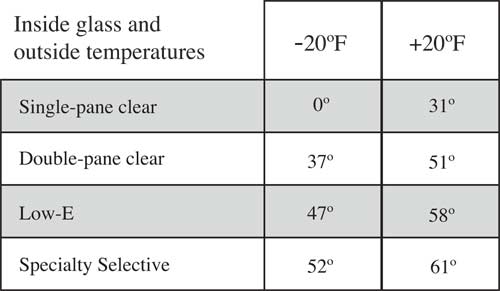New Glass Technologies Improve Performance of Architectural Glass
Spectrally Selective Glass
Widely considered to the next generation of low-E glass, spectrally selective coatings provide all the benefits of low-E glass along with increased heat-gain protection and greater energy savings. Special coatings distinguish between desirable light and unwelcome UV and infrared light; these coatings admit light but not heat by selectively transmitting or reflecting specific wavelengths, achieving a good shading coefficient and good visible transmittance.
Traditionally, optimum solar block was achieved at the expense of visible light transmittance. Spectrally selective coatings deliver a balance of solar control and high visibility, with the most efficient products blocking as much as 95 percent of the sun's damaging ultraviolet rays, thereby protecting furniture, carpets, curtains and wall coverings and reducing premature fading. Their energy performance derives from a manufacturing process known as "sputter deposition," which enables manufacturers to deposit a super-thin coating of alloys and metals-including titanium and silver-onto the window film to block more infrared energy, or heat, and let through more visible light. Though the ideal would be to allow through all visible light and no infrared or UV light, the technology, though rapidly evolving, has not yet achieved that capability. Some of the most advanced versions have three coatings of silver, and are virtually clear, with a visible light transmittance of 66 percent and a solar-heat-gain coefficient of 0.22, significantly better than that of tinted, ordinary low-E glass. These values represent the highest visible light transmittance and the lowest SHGC commercially available.
Â
|
Â
Spectrally selective coatings promote thermal comfort. During the cold weather, a window's insulating capability has a direct impact on occupant comfort. The Efficient Windows Collaborative, which provides unbiased information on the benefits of energy-efficient windows, suggests that when a window's surface temperature falls below 52 degrees F, there is a risk of thermal discomfort. For optimal cold weather comfort, windows should be able to maintain a surface temperature of at least 52 degrees. The chart below demonstrates the insulating capability of spectrally selective glass in comparison with low-E and single- and double-pane windows. Spectrally selective glass is significantly better than both single and double pane clear glass, and slightly ahead of low-E glass in maintaining a warm glass surface in spite of frigid outdoor temperatures.
Tinted Glass, sometimes called absorbing glass, has energy-absorbing materials within it that lower the shading coefficient and also provide a colored tint-generally bronze, gray, blue, or green. Tinted glass and tinted window films have long been used in commercial buildings to reduce heat gain through windows. Improved, lightly tinted windows are becoming more common for the residential market in the cooling-dominated climates of the Southern United States. These new coatings cut solar heat gain without reducing visibility to the extent that older tinted glasses and films have. The tinted or colored glass helps reduce glare, and by absorbing the sun's heat it reduces energy consumption and creates a more comfortable interior without obstructing the view outside. This glass is ideal for climates with intense sunlight: It reduces glare and visible light transmittance, while also keeping home and building interiors more comfortable in warm weather.
Reflective glass has better solar heat gain coefficients than tinted glass because they reflect rather than absorb most of the infrared heat. The reflective coating is made of thin layers of metals or metallic oxides deposited on the surface of the glass. While tinted and reflective glass achieves low solar heat gain coefficients, they also make the window appear dark, with traditional window films reducing the amount of natural light entering the building by as much as 88 percent.
Overall Performance
The energy efficiency of an entire window assembly can differ significantly from that of its glass. For optimal value, the energy performance of the entire window assembly is the key, including the frames and insulating glass spacers.
In addition, the building design should take into account the climate, the total window area of the building, choice of heating and cooling system, and the level of insulation. All of the factors will affect the choice of window that will produce the greatest energy savings and occupant comfort in a given situation. To determine the best choices, national rating systems have been developed to enable effective comparisons between windows.
Rating Systems
The National Fenestration Rating Council (NFRC) is a non-profit organization that administers a widely accepted, uniform and independent rating and labeling system for the energy performance of windows, doors, skylights, and attachment products. By providing a reliable way to determine a window's energy properties and to compare products, NFRC ratings enable architects and builders to determine how well a product will perform the functions of helping to cool a building in the summer, warm a building in the winter, keep out wind, and resist condensation. By using the information contained on the label, architects and builders can reliably compare one product with another, and make informed decisions about the windows, doors, and skylights they specify or buy.
NFRC adopted a new energy-performance label in 2005. It lists the manufacturer, describes the product, provides a source for additional information, and includes ratings for one or more energy performance characteristics.
Â
|











